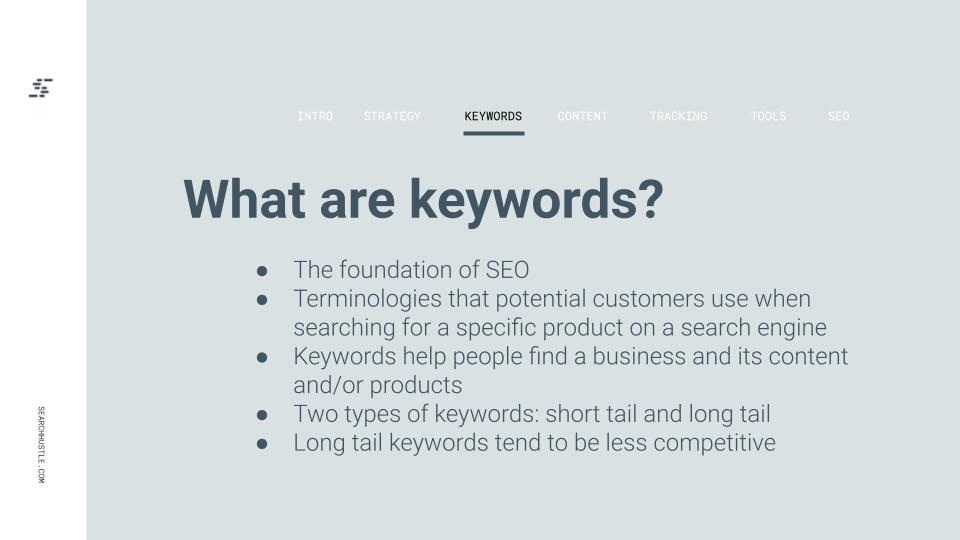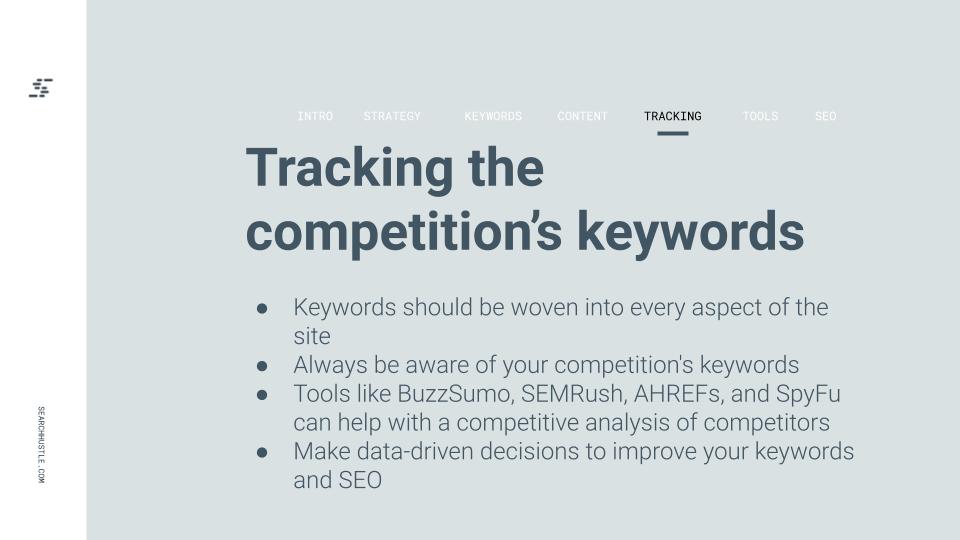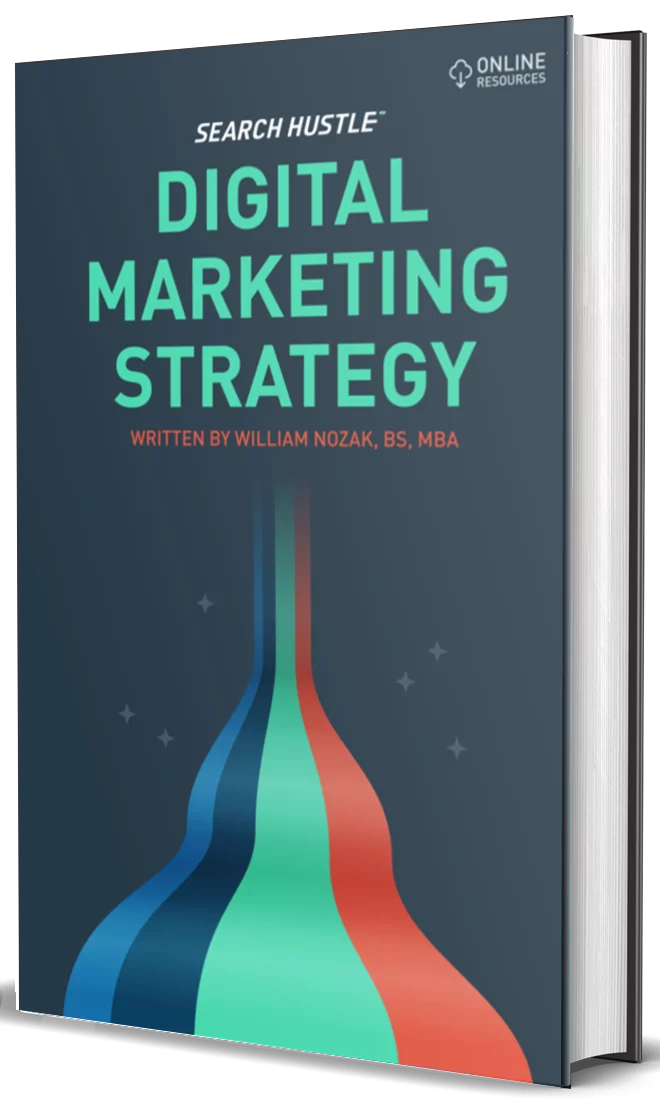Keyword and SEO Content Strategy
Search engine optimization is rapidly becoming a buzz word across all industries. Everybody from hospitals to school districts to local governments to mom-and-pop boutiques is now aware of the need for SEO in order to gain a competitive edge on the competition.

And in some regards, it’s less about getting ahead of the competition and more about not getting left in the dust. 49% of small businesses invest in SEO and large corporations often have entire digital marketing departments. Depending on the industry, the region, and the level of competition, over time, a quality SEO strategy could propel your business to No. 1 in the SERPs, or at least prevent you from dropping out of page one as your competitors attempt to make the leap ahead of you.
This chapter will focus on the importance of keywords and their use in everything from URLs to blog posts.

What are keywords?
Keywords are the foundation of SEO. Keywords are the terminologies that potential customers are using when searching for a specific product on a search engine. SEO focuses on discovering the optimal keywords that a business should be trying to rank for.
A website can be filled with valuable content, but if the keywords are wrong, nobody will ever discover that content. Hence why it’s important to fuse technical language with layman’s terms, so that customers who need your services, but don’t know a lot about your services, can find you.
There are two types of keywords(short tail & long tail), and oftentimes the most important is “long-tail” keywords. These are keywords that are often less competitive, but still valuable to rank for. A coffee shop in a big city is going to have a hard time ranking for “coffee” against the hundreds of competitors also pushing for that keyword and that single word may not even carry the intent of finding a coffee shop nearby to drink coffee.
Good keyword research can help you find additional long-tail keywords that people are searching for, but competitors aren’t competing for. Keeping with the coffee shop example, some long-tail keywords that could be used are:
- “Coffee shops with indoor seating”
- “Coffee shops with free wifi”
- “Dog-friendly coffee shops”
- “Best gourmet coffee shops”
Discovering the right keywords to implement throughout a website or page, and also keywords that direct page and post creation is an invaluable aspect of SEO that cannot be overstated.
How do I use keywords in SEO content?
Once you’ve discovered the optimal keywords to build a strategy around, there are several ways of incorporating them into your website. Keywords should be woven into every aspect of the site, from the technical side to the written copy.
First off, make sure that all keyword usage is done intentionally, strategically, and responsibly. Black-hat tactics like keyword stuffing will get a site penalized and completely blacklisted from the Google Search Index. At the same time, using the same keyword on several different pages might cause those pages to compete with one another – which is also not recommended.
Each page of a site should be built around a specific keyword (or cloud). You don’t want multiple pages competing against each other for the same keyword(s), and you don’t want one page trying to compete for so many keywords that it weakens the page and ranks for none of them.
Start from the top down. The URL should incorporate the target keywords. Whether you’re using WordPress, Squarespace, or Wix, the default for a new page or blog post is a generic string of unique characters that offer zero value to the search engine.
Instead of www.nozakconsulting.com/82957WQtF987 we used https://nozakconsulting.com/online-course-creation/ to demonstrate to Google exactly what the page is about.
Next, make sure the H2s and H3s are in scope and relevant to the target keywords. Bots understand synonyms, so you don’t need to make all of the subheadings too similar to the target keywords, but they should be in the ballpark.
Then, optimize the images to include keywords. Words in an image? That’s right. Start with the file name. Relevant and descriptive keywords should be used in the actual name of the file. Separate words with hyphens, never underscores.
Images also need to be optimized with alternative text. Alt text shows on the screen whenever an image fails to load, or is blocked by certain browsers. It is also read aloud by screen readers to visually impaired users. Not only is alt text important for reaching impaired users, it’s also crawled by search engines, so use your keywords in the text, which should also be very descriptive.
Finally, the keywords should be used throughout the copy of the page or blog. It’s important to maintain good keyword density. A good density is around 1 to 3%, or once every 50-100 words. This is enough to tell the search engines multiple times what the page is about, but not so much as to qualify as keyword stuffing.
As we’ve mentioned before, keyword stuffing is a black-hat tactic that can cause Google to remove a site from its index.
So how do you communicate the keywords multiple times without upsetting the search engines? Through lengthy content.
It’s very difficult to rank for keywords with only a couple of paragraphs, unless those keywords are utterly noncompetitive. For SEO purposes, a blog should be at least 1,5000 words, and over 2,000 is preferred – in some cases a smaller length might perform.
SEO is all about providing value to the user, so a couple of short paragraphs full of redundant keywords is pointless. Focus on providing a valuable article that you, yourself, would want to read. Then you can safely use the target keywords multiple times and improve your ranking organically.

Track the competition’s keywords
Whether you’re a small town restaurant or a national retailer, it’s important to be aware of your competition’s keywords. Just like you analyze their prices, their wages, and all of their operational strengths and weaknesses, you should also monitor keywords the same way.
Tools like BuzzSumo, SEM Rush, AHREFS, and SpyFu can help you conduct a competitive analysis of the sites you want to emulate, so you can get an idea as to which keywords they’re attacking. Then, take that information and look for opportunities to beat them at their own game.
What keyword tools can I use?
One of the most valuable and easiest SEO keyword tools to use is Google Search Console. The Search Console performance report tells you which of your pages is generating the most impressions, the most clicks, the average position in the SERPs, and your click-through rate.
The performance report tells you which pages are most valuable, and which need to be beefed up with additional content or reoptimized to improve the ranking.
Google Keyword Planner is another great free resource. Although it’s technically part of Google Ads, and intended for SEM, it can give you ideas for organic targeting as well. Simply input a website URL, and Keyword Planner will automatically generate a list of suggested keywords, along with the average monthly searches, the level of competition, and the average cost per click if you were to target the top or bottom of the page in a PPC campaign.
AHREFS also has a Keyword Explorer that is among the best paid options and our SEO tool of choice for many situations.
What is SEO content?
Blog posts
Blogs are massively important. Blogs help you build brand awareness, direct traffic towards your most important pages, and compound organic traffic. The frequency is up to you, but the goal should always be to outperform your competitors. Some industries can get by with monthly posting, some post weekly, and lots of industries need daily posting.
Don’t get burned out, however. It’s important not to lose momentum, so only publish at a schedule you can keep up with, or hire a third party like Nozak Consulting to help produce additional content.
Not every post has to be an authoritative exposé that brings groundbreaking insights into a subject. Blogs can be as simple as “Employee of the Month/Week” bios, how-to guides, product reviews, industry myths, success stories, giveaways, etc.
Don’t forget to use internal linking to point back at your primary pages!
Evergreen Content
Evergreen content is pages that are always relevant and fresh for readers. These aren’t dated blogs, these are primary pages that get continually updated annually, quarterly, or even monthly to ensure that they are still on top of the ever-changing industry trends.
Evergreen pages are a great way to attract passive web traffic and generate leads that never dry up, whereas outdated blogs tend to have a shorter life expectancy which would stop bringing SERP visitors if they stop ranking in engines.
Think evergreen blogs, because while blog content speaks to additional topics – an evergreen blog can capitalize on the trends & information changes – keeping a page/post relevant and up to date.
Videos
Video is a massive part of SEO that most people outside of the fulfillment industry rarely think of. However, studies show that optimized video content on a web page directly influences its position in the SERPs.
While uploading video to the Vimeo, Wistia or Youtube platforms can help with general brand awareness, training, education, and even pushing traffic to certain pages on your website (from the bio sections) – embedding it directly in a site can drive traffic to the site, from search engines (assuming the videos are indexable, don’t cause more speed issues than they are worth, and the video is marked up appropriately for bots).
Inserting a video transcript is a big opportunity because transcripts act as copy and are scrapable by bots. Longer videos with lots of oral content are gold mines for free copy. The title and description of the video are also valuable opportunities to utilize keywords.
Interactive Tools
Interactive tools such as BMI calculators, nickname generators, nutrition and calorie calculators, surveys, infographics, quizzes, and e-books all serve to keep people engaged and on the page, resulting in higher dwell time, which Google rewards.
Product Service Pages
Product service pages are a great way to beef up a website. Nobody knows more about your services and products than you. You are the expert. You are the authority on the subject. Write a page for every product and service you offer, make it substantial, and watch the leads and traffic pour in.
What is an SEO Content Strategy?
Search engine optimization must be strategic. Throwing darts at a wall and hoping they stick is no way to optimize a site and generate revenue. Everything you do should be intentional and measurable, with a specific goal in mind.
Create a list of topics
Getting a general idea of what you want to market is the first step. A company that sells shooting targets, for instance, could also write about guns, ammunition, new policies affecting shooting hobbyists, gun safety, etc.
A dentist can write about topics such as routine checkups, dental bridges and implants, emergency procedures, root canals, crowns, invisalign, braces, etc.
Fully flesh out everything in your space that could attract relevant traffic and leads.
Do keyword research
Conduct the research. Analyze the competition. Make sure you’re using the terminologies that people are searching for. Don’t use technical language if your target audience is the layman who needs your services but doesn’t know much about them. Don’t use layman’s terms if your target audience is fellow professionals who need to find you authoritative.
Build pages for each topic
Build a primary page for each topic you want to rank for. Make sure the pages aren’t competing with each other by keeping them all in scope. Optimize the pages through URLs, metadata, images, and videos that all utilize the target keyword.
Create a blogging schedule
Make sure you can generate enough content to match or beat your competition. If you struggle with writer’s block, hire a third-party fulfillment agency to do the work for you. Regular posting on a blog tells the search engines that you are an authority on a subject, it drives traffic to your site, and it provides the opportunity for a strong internal linking structure that strengthens the authority of your topic pages.
Don’t forget backlinks
Don’t let anybody tell you that backlinks are no longer important. Sure, at one time a link from an authoritative site would have a direct and immediate impact on your own domain authority. But just because they’re not as weighty as they used to be, doesn’t mean they’re not still important.
Getting listed in white-hat directories and submitting guest posts to popular blogs can improve your standing in the SERPs by showing Google that you’re a legitimate enterprise and site that offers valuable information and services to searchers.
Stay current on SEO practices and news
SEO is always changing as Google continually updates its algorithms in its efforts to present only the best results to its users. Stay well-read on current best practices and updates. Moz, and SEOFOMO offer great newsletters, or digital curriculum platforms like Search Hustle are frequently posting up-to-date video insights into the ever-changing world of digital marketing.
Measure and track your content’s success
Tracking your investment is hugely important, otherwise SEO will never feel worthwhile. You need measurable data that shows the value of your investment. Track your page rankings, organic traffic, dwell time, click-through rate, and bounce rate to measure improvement and make sure you’re on top of any dips in performance.

Ready to Take Your Search Hustle Further?



